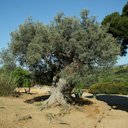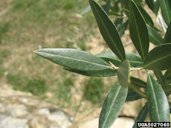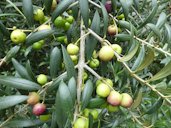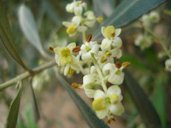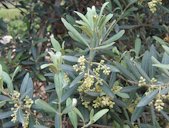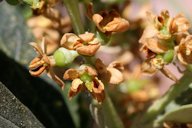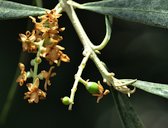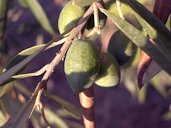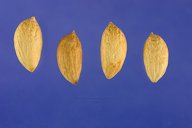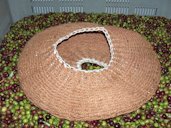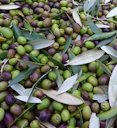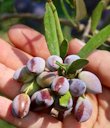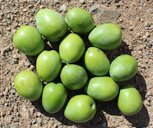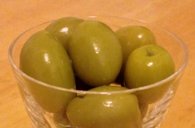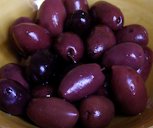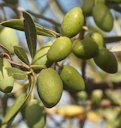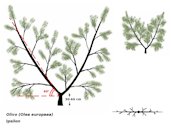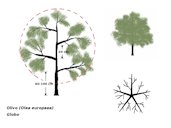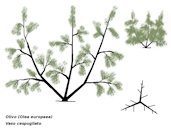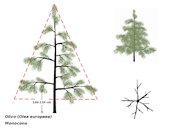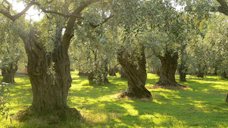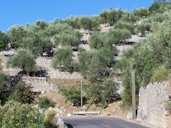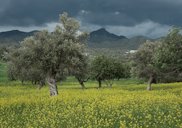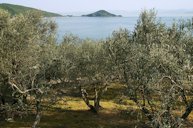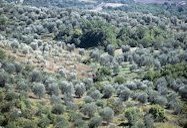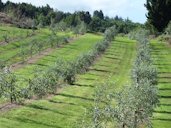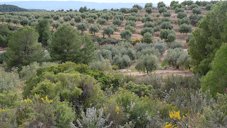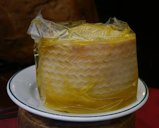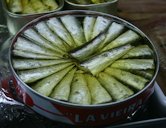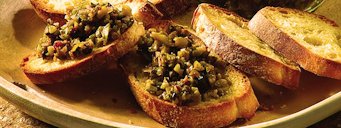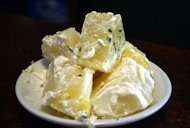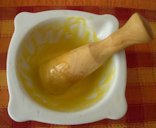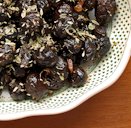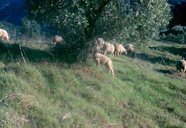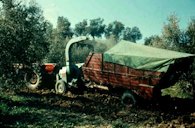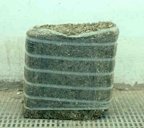| Olive - Olea europaea | |||||||||||||||||||||||||||||||||||||||||||||||||||||||||||||||||||||||||||||||||||||||||||||||||||||||||||||||||||||||
|---|---|---|---|---|---|---|---|---|---|---|---|---|---|---|---|---|---|---|---|---|---|---|---|---|---|---|---|---|---|---|---|---|---|---|---|---|---|---|---|---|---|---|---|---|---|---|---|---|---|---|---|---|---|---|---|---|---|---|---|---|---|---|---|---|---|---|---|---|---|---|---|---|---|---|---|---|---|---|---|---|---|---|---|---|---|---|---|---|---|---|---|---|---|---|---|---|---|---|---|---|---|---|---|---|---|---|---|---|---|---|---|---|---|---|---|---|---|---|---|
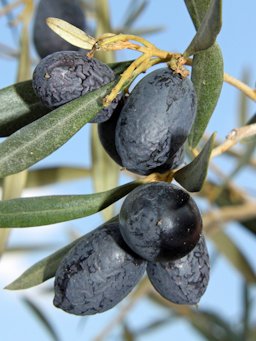 Fig. 1  Olea europaea, Olive, Karlsruhe, Germany 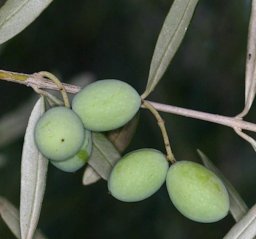 Fig. 2  Fruits of Olea europaea 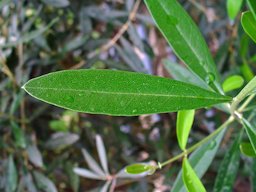 Fig. 3  O. europaea, Olive, leaf; Karlsruhe, Germany 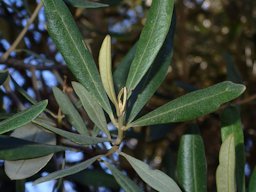 Fig. 4  O. europaea. Los Angeles, California 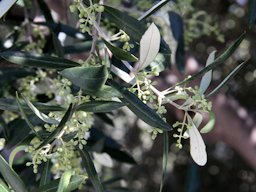 Fig. 12  O. europaea L., Sicilia, Itália 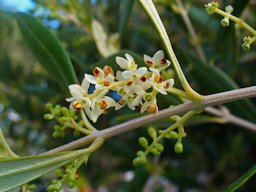 Fig. 13  O. europaea flowers, Forest of Olive trees. Karlsruhe, Germany 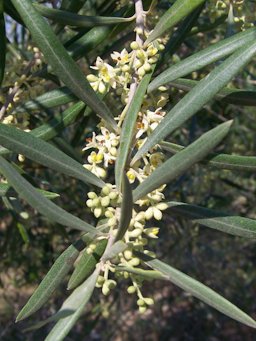 Fig. 14  O.europea (Olivo) Rama en flor - Camino de Elche, Albatera (Alicante, Espana) 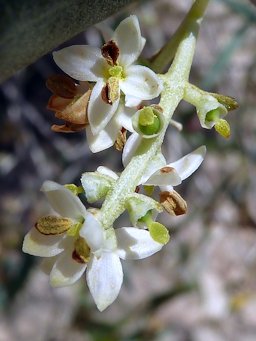 Fig. 15  O. europaea (Olivo): Flores, detalle - La Huerta, Albatera (Provincia de Alicante, España) 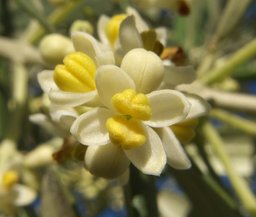 Fig. 16  Flor de olivo (Madrid) 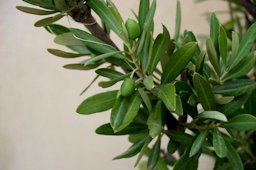 Fig. 20  O. europaea: Foliage and fruit Le Barroux, Provence Fig. 21  O. europaea, Olive, developing fruits 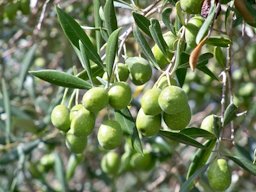 Fig. 22  O. europaea habit 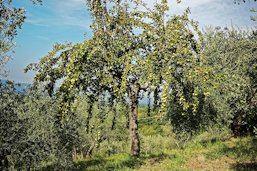 Fig. 23  Olivenbäume in der Toskana, O. europaea. Olive trees (in full fruit) in Tuscany 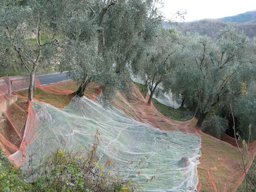 Fig. 40  Ligurian olive harvest 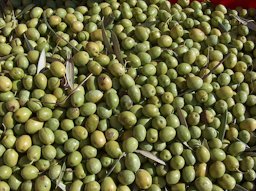 Fig. 41  Olives for oil. Cultivar Bosana, Sardinia, Italy 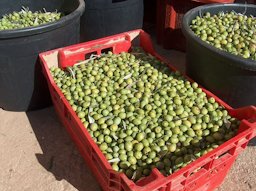 Fig. 42  Olive fruits prepared for oil extraction 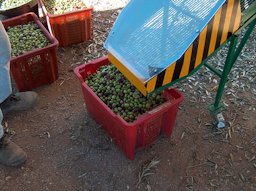 Fig.43  Grading of olive fruits to remove the foliage 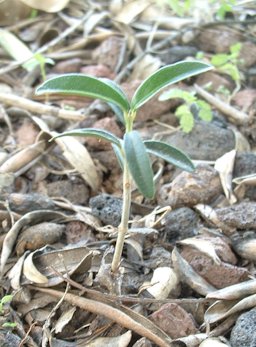 Fig. 44  Young olive (O. europaea) plant, that germinated from a seed. Karkur, Israel. 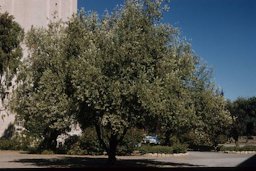 Fig. 45  O. europaea L. Palo Alto, California Fig. 46 O. europaea bark, Forest of olive trees. Karlsruhe, Germany  Fig. 52  A four-year-old olive grove in north central Florida 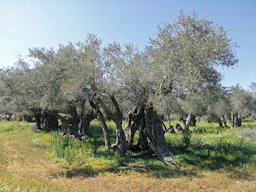 Fig. 53  O. europaea 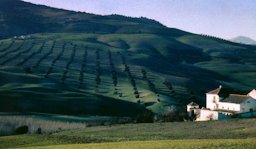 Fig. 54  Farmhouse with olive groves, near Alhama, Spain 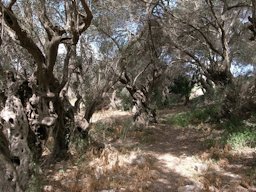 Fig. 55  O. europaea Grove Wardija Ridge Malta. 1000-2000 years old. 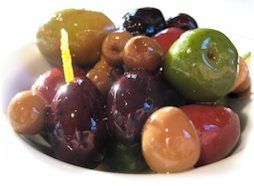 Fig. 64 "I love olives, but I just starting noticing this in the past couple years. I used to think of them as tasteless salt rings, the parsley of pizza. But now, I am amazed at their variety of sizes, tastes and colors. Without a scale reference, this could be a lubricated still life with green apple, eggplant and mango." 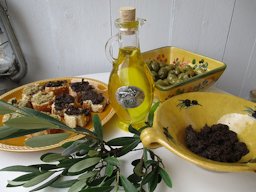 Fig. 65  Huile d'olive provençale, olives, banche d'olivier, tapenade, et terre cuite provençale 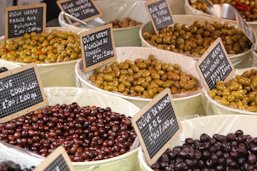 Fig. 66  Olives au marche d'Apt, France Fig. 87  Défilé d'ouverture de la fête de l'olive et de l'huile à Buis-les-Baronnies. Chevalier de l'olivier de Nyons.  Fig. 88 Martini Splash |
Scientific
name Olea europaea L. Pronunciation O-lee-a eu-ro-PIE-a Common names English: olive, olive tree, oliveleaf; French: olivier; French Polynesia: orive; Portuguese: oliveira, azeitona; Germany: Oelbaum; Olivenbaum; Israel: zayit; Netherlands: Olijfboom; Swahili: mzaituni, mzeituni; Swedish: olivträd; Arabic: az-zeitoun; Chinese: mu xi lan; USA/Hawai'i: ‘oliwa; ‘oliwa haole 10,15 Synonyms • Cultivated olive: O. europaea L. var. europaea, O. europaea L. subsp. europaea, O. gallica Miller, O. hispanica Miller, O. lancifolia Moench, O. sativa Gaterau, O. europaea L. var. sativa Lehr., O. europaea L. var. sativa Loud., O. europaea L. subsp. sativa Arcang. • Wild olive: O. europaea L. var. sylvestris (Miller) Lehr., O. sylvestris Miller, O. europaea L. subsp. sylvestris (Miller) Rouy, O. europaea L. subsp. sylvestris (Miller) Hegi, O. europaea L. var. sylvestris Brot., O. oleaster Hoffmannsegg & Link, O. europaea L. subsp. oleaster (Hoffmannsegg & Link) Negodi 3 Relatives Wild Olive (O. africana), Oleaster (O. europaea var. oleaster) 4 Family Oleaceae (olive family) Origin Native to the Mediterranean, Asia, and Africa 1 USDA hardiness zones 8-10 Uses Food; olive oil; hair care, body oils, extracts; wood; landscape design 2,9 Height 32- 50 ft (10-15m) 3 Spread 30 ft (9 m) 4 Crown Broad multibranched crown 3 Plant habit Evergreen tree, or densely branched shrub 3 Growth rate Very slow 8 Longevity Commercial life span: about 50 years; individual trees can become very old (hundreds of years) 3 Trunk/bark/branches Trunk thick; often gnarled; Initially gray-green, becoming tan as it matures; corky lenticels (Fig. 47); bark irregular 1,3 Pruning requirement Keep at 8-10 ft (2.4-3 m) 1 Leaves Evergreen; opposite, elliptical, narrow /sharp apex; grey green appearing almost white to silver 1 Flowers Small; fragrant; cream-colored; on a long stem from leaf axils; perfect flower (male and female) and staminate; April and May 4 Fruit Drupe; stony seed; green, becoming blackish-purple when ripe; shape/size vary by cultivar 1 Season Aug. through Nov. depending on cultivar Light requirement Full sun Soil tolerances Sand-dominated soils are best as olives are susceptible to root rot diseases 1 pH preference Up to 8.5 1 USDA Nutrient Content: green olive, olive oil pdf Drought tolerance Tolerate drought well, due to their sturdy and extensive root system 9 Soil salt tolerance Tolerant of mild saline conditions 1 Cold tolerance Not below 10.5 °F (-12 °C); fruit damaged at 29 °F (-1.7 °C) 6 Plant spacing 8-10 ft (2.4-3 m) between plants, 16-25 ft (4.9-7.6 m) between rows; hedgerow 10 ft x 20 ft (3 m x 6 m) 1 Roots Extensive with main roots thickened due to fasciation 3 Invasive potential * None reported Pest/Disease resistance Relatively pest and disease-free tree 1 Known hazard Olive tree pollen is extremely allergenic, with an OPALS allergy scale rating of 10 out of 10. O. europaea is primarily wind-pollinated, and their light, buoyant pollen is a strong trigger for asthma. 8 Reading Material Olives for Your Florida Landscape, University of Florida pdf Olives in Florida? Vegetable and Specialty Crop News Research Progress on Growing Olives in Florida, Vegetable and Specialty Crop News Olea europaea, PROSEA Foundation Olive, Progress in New Crops, Purdue University Olive oil: history, production, and characteristics of the world's classic oils, HortScience pdf Origin/Distribution The olive (Olea europaea) is a stone fruit from a species of small tree in the family Oleaceae. Olives are found primarily in the Mediterranean Basin and across the countries of the middle east and north Africa (MENA). Olives are now cultivated in India and as far east as China, Java, Australia and the Philippines. Off north Africa, olives are found in the The Canary and Réunion Islands. Spanish settlers brought olive trees to the New World. Olives are now cultivated in Mexico, Argentina, Peru, Chile and several other Central and South American countries. In the United States, olives are grown in Texas, Alabama, Georgia, Florida, Arizona and California. There are olive trees on Bermuda and on the U.S. East Coast barrier islands in Georgia and the Carolinas (Norfolk Island and Cumberland Island). 2 Note: Researchers have been testing olive trees as far south as Orlando. Growers further south will have to decide whether it's worth the chance or wait for more research to be done to see just how far south these trees will grow and thrive. 7 Description The olive is an evergreen tree growing to 50 ft. in height with a spread of about 30 ft. The graceful, billowing appearance of the olive tree can be rather attractive. In an all-green garden its grayish foliage serves as an interesting accent. The attractive, gnarled branching pattern is also quite distinctive. Olives are long-lived with a life expectancy of 500 years. The trees are also tenacious, easily sprouting back (Fig. 9) even when chopped to the ground. 4
Fig. 6. Olivträd i närbild, Grekland (O. europaea in Greece) Fig. 7. O. europaea L., Sicilia, Itália. Fig. 8. O. europaea Grove Wardija Ridge Malta. 1000-2000 years old. Fig. 9. Olivenbäume in der Toskana, O. europaea. Olive tree in Tuscany. Leaves Leaves are simple, entire, lanceolate to ovate-lanceolate or elliptic in form, and with smooth margins. The leaf blade is 3-9 cm long and 1-2 cm wide, with a very distinctive central vein and many but less apparent secondary veins. Leaf Margins are smooth and the petiole is very short, sometimes barely noticeable. 16 Leaf color is variable but is generally described as gray-green on the upper surface and much lighter on the lower surface; sometimes appearing almost white to silver. The leaves are this color on the underside owing to the presence of many scale-like hairs that trap moisture in the leaves. As with many evergreen species, the two- to three-year-old leaves usually fall at the same time new growth appears in the spring. 1
Fig. 10. Olive (O. europaea) L. foliage Fig. 11. Fruit leaves at Skyline Zipline Crater Rd, Maui, Hawai'i. (branch habit) Flowers Olive flowers are borne on 1.5-4.0 cm long inflorescenses that form from buds in the leaf axils of 1 year-old wood. 16 Most olive varieties are somewhat self-incompatible and several have recently been shown to be self-sterile. Flowers are produced on small inflorescences that emerge in the axil of the leaf from portions of the stem that grew the previous season (Fig. 19c). The flowers typically open in April or May in Florida, but have been reported as early as February 20th. The individual inflorescence, known as a panicle, is highly branched, with 10 to 40 flowers on an individual inflorescence. 1
Fig. 17. O. europaea L. Fig. 18. Olive Blossoms outside Jerusalem Fig. 19. Phenological development of Olive flowering, following BBCH standard scale. a-50, b-51, c-54, d-57, (<15% open flowers); f-65, (>15% open flowers); g-67, (<15% open flowers); h-68. Fruit The fruit type is a drupe. Fruit are oblong with smooth, waxy surfaces. Color is green when immature, turning yellow-green in autumn, with red, purple, or black coloration at full maturity. Dark coloration results from anthocyanin production in the exocarp and mesocarp. A stony pit surrounds a single seed. 11 Mainly oleuropein but also other phenolic compounds are responsible for the intense bitterness of olive fruits, as well as for fruit blackening and inhibition of microorganisms during processing. The bitterness in table olives is largely removed in the early stages of processing. 3 Olive fruit development takes 6.5-7 months from anthesis to harvesting, the last 20-40 days being essential for oil formation in the mesocarp. 3
Fig. 24,25. Very young fruits of an olive tree Fig. 26. Olive tree fruits in August. They are full size, but still not ripe. Bela Vista, Lisboa, Portugal. Fig. 27. O. europaea subsp. europaea (European olive). Fruit leaves. Skyline Zipline Crater Rd, Maui, Hawai'i. Fig. 28. O. europaea L. illustration Fig. 29. O. europaea L. seeds Varieties According to their use, three groups of cultivars can be distinguished: • Cultivars for oil extraction, e.g. 'Picual' (Fig. 30), 'Arbequina' (Fig. 31) and 'Blanqueta' in Spain; 'Frantoio' (Fig. 32) and 'Leccino' (Fig. 33) in Italy and 'Koroneiki' (Fig. 34) in Greece. • Cultivars for fruit consumption, e.g. 'Gordal Sevillana' (Fig. 35) and 'Manzanilla de Sevilla' (Fig. 36) in Spain, 'Conservolea', 'Kalamata' (Fig. 37) and 'Chaldiki' in Greece, 'Picholine du Languedoc' (Fig. 38) in France, 'Manzanillo' and 'Mission' in the United States and 'Oliva di Spagna' and 'Oliva di Cerignola' in Italy. • Dual-purpose cultivars (for oil extraction and fruit consumption), e.g. 'Hojiblanca', 'Manzanilla Cacereña' and 'Aloreña' in Spain, 'Tanche' in France, 'Picholine marocaine' in Morocco, 'Dan' in Syria and 'Arauco' in Argentina. 3 The cultivar 'Arbequina' from Spain has been the most popular in Florida. It is a self-pollinator, meaning it can use its own pollen to fertilize and produce fruit, but having other cultivars nearby seems to help. 'Koroneiki' and 'Arbosona' are often planted to support pollination of 'Arbequina'. 'Mission', the common black "table olive" (for eating as opposed to those better for oil), is another cultivar that is self-fertile and may do well in a Florida landscape. 7
Fig. 30. Cultivar 'Picual', Castelltallat, Catalonia, Spain Fig. 31. 'Arbequina', Catalonia, Spain Fig. 32. 'Frantoio', Sardinia, Italy Fig. 33. 'Leccino', Tuscany, Italy Fig. 34. An olive grower shows 'koroneiki' olives ripe for harvest. Corning, California Fig. 35. Detalle de aceitunas de la variedad 'Gordal Sevillana' Fig. 36. 'Manzanilla' olives, Spain Fig. 37. 'Kalamata' olives, Greece Fig. 38. 'Picholine' olives, Franc Fig. 39. 'Hojiblanca', Catalonia, Spain Olive, What Cultivar is That? STFC Queensland Pollination Olive flowers are fertilized by wind-blown pollen. Several varieties of olive are self-fertile and may fertilize their own flowers with their wind-blown pollen. However, research has shown that some trees that may be self-fertile in the regions where they were selected and developed may become self-infertile when grown in another region of the world. These differences in reproductive compatibility can be influenced by both fall and spring weather conditions. 1 If fruit production is a primary objective of olive culture, at least two distinct cultivars should be planted in close proximity to each other to facilitate transfer of the wind-borne pollen. 1 Propagation Practically all olive trees in the world are grown from clonal cultivars. Seeds germinate within 25-50 days after sowing, but seed viability of cultivated olives is generally low. The main method of propagation of olive is based on rooting of semi-hardwood cuttings prepared from one-year old branches (10-12 cm long with 4-5 nodes and two pairs of leaves). Olive seedlings have a distinct juvenile phase lasting 4-9 years and characterized by strong vegetative growth and profuse branching. Plants raised from cuttings have a more adult growth habit with monopodial branching and may start flowering within 3-7 years after field planting. 3 Due to the ease of rooting, most olives are grown on their own roots, from cuttings, suckers, or ovuli. There are no particular rootstocks of worldwide importance. 11
Fig. 47. Grafting of olive tree (O. europaea) Mallorca. Patch Budding: A Convenient Method for Top-Working Olives, University of California, ANR pdf Climate Olive trees cannot survive temperatures below 10.5 °F. Trees will be damaged if temperatures fall below 22 °F, especially if dormancy is interrupted by fertilizing or irrigating after September. New growth (young shoots) and olives (fruit) are damaged at temperatures below 29 °F. Unseasonal freeze events (late autumn, early spring) or winter warmth will decrease overall cold tolerance. 6 Its root system is robust and capable of regenerating the tree even if the above-ground structure is destroyed. 8 Florida Low-Chill Olive Research Note-July 2022, Florida Olive Council pdf Soil Olive trees show a marked preference for calcareous soils, flourishing best on limestone slopes and crags, and coastal climate conditions. They grow in any light soil, even on clay if well drained, but in rich soils, they are predisposed to disease and produce poorer oil than in poorer soil. (This was noted by Pliny the Elder.) 8 Roots The root system structure depends on the propagative origin of the tree, whether form germinated seed or rooted cutting, and soil conditions. Seedlings generate a single long taproot, which dominates during the first years of growth with limited lateral branching. When trees are produced from rooted cuttings, the case for the majority of commercially produced trees, the root system originates from the multiple adventitious roots formed at the cutting base. 16 Root system is extensive with main roots thickened due to fasciation, up to 6 m deep in porous soils and spreading laterally with dense mat of feeder roots; protuberances (spheroblasts) at the base of trunk with additional lateral roots. 3 Pruning Because flowering occurs on new growth emerging from the growth of the previous season, pruning can be tricky. Pruning is important in regulating flowering and may be used to shape the tree to assist with fruit harvest and will also improve air movement to reduce fungal disease. Olive trees will respond to radical pruning to control either height or plant form, but the impacts on flowering and fruiting should be considered. The olive never bears fruit twice in the same place on a stem, so new growth each year is essential to flower and fruit production the following year. 1 Young trees may be headed to promote initial branching, and shoots below 2.5 to 3′ removed to allow shaker attachment for mechanical harvest. Afterwards, undesirable limbs are thinned and suckers removed from the trunk, and trees branch naturally on their own. 11 Although when pruned, cultivated olive could reach 15 m. It is able to develop suckers and roots from temporary buds generated by neoplasm formation in the base of the trunk just below the soil surface. These formations are known as 'ovules' and are of considerable importance in conserving the tree as they continue to form and grow as the tree becomes old. 15 Winter pruning is performed after the end of winter, when major frost risk to new growth has passed, and before flowering has started. When done after bud-break, it also presents the advantage that the future flowering sites are visible. 16 Thinning Fruit size may be increased somewhat by reducing the number of fruit per branch or thinning the crop. Thinning to two or three fruit per foot of twig is done soon after fruit set. 1 Growing Systems in Sardinia
Fig. 48. Olive-tree growing systems: ipsilon form Fig. 49. Olive-tree growing systems: globe form Fig. 50. Olive growing system: "Vaso cespugliato" (a vase form without trunk) Fig. 51. Olive-tree growing systems: monocone form Olive Groves Around the World
Fig. 56. Olive trees on Thassos, Greece Fig. 57. Oliveraie cultivee en terrasses ("rectanques") dans le quartier de la "Porte Rouge" du village de Levens, Alpes-Maritimes, France Fig. 58. Olive grove in Cyprus Fig. 59. Shodoshima Olive Park of Shōdo Island, Shodoshima, Kagawa prefecture, Japan Fig. 60. Olivenfelder bei, (olive fields) Tuscany Fig. 61. O. europaea subsp. europaea (European olive). Orchard Waipoli Rd Kula, Maui, Hawai'i. Fig. 62. Olive grove of 'Arbequina' olive trees in Bovera, Catalonia, Spain Fig. 63. Old Sevillano Olive Tree in Corning, California, US Fertilizing Nutrient requirements for olive are low, and the trees do not produce well on highly fertile soils. Olive is a rapidly growing plant, and while growth increases are possible with supplemental nitrogen (N) fertilization, too much N will cause excessive vegetative (shoot) growth at the expense of reproductive growth (fruiting). Although nutrient deficiencies are uncommon, excessive N will negatively affect fruiting and oil quality. 1 Guide to Olive Tree Nutrition in Florida, University of Florida pdf Irrigation Olive leaves are relatively small and have a protective cuticle which slows water loss, allowing olives to survive extended dry periods. An overabundance of moisture may cause the flowers to drop and reduce fruit yield. 1 The number #1 killer of olives is too much water. Once the olive roots become saturated, the tree will not live long. Almost nothing else will kill an olive tree. It will freeze and appear dead but often it will come back from the roots. 2 Without irrigation the fruit-bearing age of the olive tree is about 9 years. This period can be halved when the olive trees are grown under intensive conditions including irrigation and fertilisation. The fruiting age is also cultivar dependent. Olive trees are alternate year bearing, with a heavier crop being produced every second year. Alternate year bearing can be evened out with irrigation. 14 Pests/Diseases Olives are thought to be a relatively pest- and disease-free tree in much of the world, with the exception of a few invasive species that have become pests of olives in the last few years. Home gardeners will have few complaints about pests unless they cause an aesthetic injury like leaf discoloration or leaf damage. 1 Pests and Fungal Organisms Identified on Olives (Olea europaea) in Florida, University of Florida pdf Pest Research for Florida Olives, Vegetable and Specialty Crop News Develop Your Own Florida Olive IPM Plan, University of Florida pdf Harvesting Olive is a strongly biennial bearer, because a heavy fruit load in one year inhibits adequate shoot extension necessary for the following years bearing wood and vice versa. 3 Olives for oil are harvested at full maturity in late autumn or early winter, either mechanically or with the use of rakes, beating poles and collecting nets. Table olives are harvested by hand; mature green fruits in early autumn and black olives in late autumn. Manual fruit picking (capacity about 80 kg/person per day) accounts for 50-60% of field production costs. Machines developed to reduce harvesting costs include trunk and branch shakers in combination with inverted umbrellas or rolling canvas frames to catch the fruits. 3 About 5-6 kg (11-13 pd) of fruits are needed to produce 1 kg (35 oz) oil. 3 Olive Harvest Methods Processing Oil extraction should start within 3-4 days after fruit harvesting to avoid a change in flavour and increase in free fatty acid content. The fruits are washed, crushed and mashed into a paste, from which the oil is cold-extracted by mechanical pressing. The 'margine', or mixture of water and oil, is allowed to settle and the oil is separated by decantation, centrifugation and filtration. Oil prepared exclusively by this process, i.e. by physical means only and without any heating, is called virgin olive oil. 3 The general rule of thumb is that an olive oil keeps for up to 18 months to two years from the time it is pressed, so be sure and look for a harvest date (the best EVOO's (extra virgin olive oil) are harvested and pressed within 24 hours) on the label. Once opening the bottle, you should use the oil (“Generously!” says Creanza) within approximately two months. 12 'Lampante' virgin oil and oil obtained by heating or solvent extraction are either used industrially or have to be refined by neutralization, bleaching and deodorization to produce refined olive oil. Further solvent extraction may be done to produce an industrial grade oil from the cake. 3 Preservation of table olives starts with soaking fruits in an alkaline solution to reduce the bitterness before pickling in brine (Spanish-style and Californian-style). The Greek-style preservation of fully ripe, black olives involves pickling in brine without alkaline pre-treatment. 3 Olive Oil Extraction Process Olive Oil and Olive-Pomace Oil Grades and Standards Food Uses The main product of the olive tree is the edible oil extracted from the fruit's mesocarp and commonly used as a cooking and salad oil and in the preservation of various foods. 3 Olive oil is classified into two main quality classes: cold-pressed or virgin oil and refined olive oil. Virgin olive oil is one of the few vegetable oils that is traded and consumed without any refinement and contains its full complement of secondary compounds. 3 Olive oil is used as a cooking oil, in salad dressings, and as a food preservative; in some places, such as the United Kingdom, it is used in a spread. 8 Olives typically are not eaten raw from the tree and are considered unpalatable as they contain an alkaloid that makes them bitter. 1
Fig. 67. Ensalada caprese Chef koketo Fig. 68. Queso manchego en una forma moderna de envasado al vacío, con aceite. Castilla-La Mancha, España. (Vacuum packed in oilive oil as a method of conservation) Fig. 69. Sardinas enlatadas (canned sardines in oil) Fig. 70. Artisan tortas de aceite ('olive oil flat cakes') at display on a patisserie of Seville (Spain) Fig. 71. Olivada à base d'aubergines et tartines grillées Fig. 72. Patatas Ali-Oli Fig. 73. Selfmade Allioli/Aioli after a Catalan recipe, consisting of garlic, salt, egg, and olive oil Fig. 74. Aceitunas prietas. Region of La Campiña, province of Seville, Andalusia, Spain. Fig. 75. Organic Extra Virgin Olive Oil Premium Category Table Olives, International Olive Council Olives: Safe Methods for Home Pickling, University of California pdf Olive Tips, STFC Queensland Medicinal Properties ** It is much appreciated for its specific flavour and supposedly beneficial effects on health due to the high concentration of monounsaturated fatty acids and polyphenolic anti-oxidants. 3 Health Benefits of Olive Oil and Olive Extracts, University of Florida pdf Other Uses Lower grade olive oils are used in the manufacturing of soap (Fig. 77), cosmetics and lubricants. Traditionally, olive oil also has various pharmaceutical applications and has served as lamp oil. 3 Other useful products from the olive tree include the leaves as cattle feed, valuable timber from the stem, and firewood from the branches. Olive trees are planted for ornamental purposes, as firebreaks and to control soil erosion. 3 Olive wood is very hard and is prized for its durability, colour, high combustion temperature, and interesting grain patterns. Because of the commercial importance of the fruit, and the slow growth and relatively small size of the tree, olive wood and its products are relatively expensive. Common uses of the wood include: kitchen utensils (Fig.80), carved wooden bowls, cutting boards, fine furniture, and decorative items (Fig.78 ). 8 Browsing of olive forage is used in integrated systems combining livestock and olive oil production. The trees are browsed after olive harvest, and only during winter and spring. Ruminants (mainly sheep) are allowed to enter the olive tree fields and browse freely. Olive foliage may also be ensiled provided the conditions are anaerobic (Gomez Cabrera, 2010, personal communication). 13
Fig. 76. Savonettes. Soaps made of olive oil, France. Fig. 77. Sculpture of Christ bearing the cross in olive wood in the Nostra Signora del Sacro Cuore church in Rome. Fig. 78. Gegenstände aus Olivenholz, Germany. Fig. 79. Olive trees, O. europaea, and browsing sheep, Andalusia, Spain. Fig. 80. Olive forage chopping machine, Andalusia, Spain. Fig. 81. Olive forage in high pressure bale, Andalusia, Spain. General A quality extra virgin olive oil should smell and taste fresh, have fruity notes (descriptors might include grassy, apple, green banana, artichoke and herbaceous), and may have bitterness and spiciness (which are indicators of healthy antioxidants.) 5 The anti-oxidant effect of the phenolic compounds (50-400 ppm) and the high oleic content combine to give an oil of exceptional stability even during deep frying. 3 Producer organizations such as the California Olive Oil Council and the Australian Olive Association require olive oil to meet quality standards that are stricter than the minimal USDA standards. Other seals may not offer such assurance. 5 Olive oil has long been considered sacred. The olive branch was often a symbol of abundance, glory, and peace. The leafy branches of the olive tree were ritually offered to deities and powerful figures as emblems of benediction and purification, and they were used to crown the victors of friendly games and bloody wars. Today, olive oil is still used in many religious ceremonies. Over the years, the olive has also been used to symbolize wisdom, fertility, power, and purity. 8
Fig. 82. European Olive (O. europaea). National Arboretum Bonsai Collection Training Date 1970. Fig. 83. Lacydon Street, Marseille, Bouches-du-Rhône, France. Fig. 84. 1908 Indian Head Gold coin. Reverse shows the eagle holding an olive branch. Fig. 85. Reverse detail showing the mintmark surrounded by an olive branch. Fig. 86. Stamp of Italy; 1948; airmail stamp of the issue "Torre di Campidoglio"; stamp showing an olive tree, an aircraft and the "Torre di Campidoglio" at the Capitoline hill in Rome. Further Reading Florida Olives 2021, Florida Olive Council pdf Olive, California Rare Fruit Growers Growing Olives In Western Australia, Archives of the Rare Fruit Council of Australia Reflective Guide to Growing Olives for Oil Production in Hawai‘i, University of Hawai'i at Mānoa pdf Researchers and Growers Working with Olives, Vegetable and Specialty Crop News Florida Olive Council ext link American Olive Oil Producers Association ext link International Olive Council ext link Ceylon Olive, Elaeocarpus serratus, STFC Queensland The Olive, Archives of the Rare Fruit Council of Australia Olive Botanical Art List of Growers and Vendors |
||||||||||||||||||||||||||||||||||||||||||||||||||||||||||||||||||||||||||||||||||||||||||||||||||||||||||||||||||||||
| Bibliography 1 Thetford, Mack, et al. "Olives for Your Florida Landscape." Horticultural Sciences Dept., UF/IFAS Extension, ENH1254, Original pub. Feb. 2015, Rev. Dec. 2017, Reviewed Feb. 2022, AskIFAS, edis.ifas.ufl.edu/ep515. Accessed 1 Jan. 2020, 4Jan. 2024. 2 "What are Olives and Where do they Grow?" Florida Olive Council, floridaolive.org/olive-farming-faq/. Accessed 1 Jan. 2020. 3 Moutier, N., and H. A. M. van der Vossen. "Olea europaea L." Vegetable oils and fats, Plant Resources of South-East Asia No 14, Edited by van der Vossen, H. A. M. and Umali, B. E., PROSEA Foundation, Bogor, Indonesia, record 1530,1991, PROSEA, (CC BY-NC-SA 3.0), www.prota4u.org/prosea/view.aspx?id=834. Accessed 3 Jan. 2020. 4 "Olive." California Rare Fruit Growers, crfg.org/pubs/ff/olive.html. Accessed 4 Jan. 2020. 5 "Olive oil tips for Consumers." UC Davis Olive Center, olivecenter.ucdavis.edu/learn/olive-oil-tips-for-consumers. Accessed 4 Jan. 2020. 6 Byron, Morgan, et al. "Develop Your Own Florida Olive IPM Plan." Entomology and Nematology Dept., UF/IFAS Extension, ENY990, Original pub. Aug. 2019, Revised Dec. 2022, AskIFAS, edis.ifas.ufl.edu/in1251. Accessed 4 Jan. 2020, 4Jan. 2024. 7 "Olives." UF/IFAS Gardening Solutions, gardeningsolutions.ifas.ufl.edu/plants/edibles/fruits/olives.html. Accessed 4 Jan. 2020. 8 Shapiro, Leo. "Olive tree." Encyclopedia of Life, Article 579181, EOL, (CC BY-NC-SA 3.0). eol.org/pages/579181/articles. Accessed 4 Jan. 2020. 9 "Olive." Wikipedia, en.wikipedia.org/wiki/Olive. Accessed 9 Jan. 2020. 10 "Taxon: Olea europaea L." USDA, Agricultural Research Service, National Plant Germplasm System, Germplasm Resources Information Network (GRIN-Taxonomy), National Germplasm Resources Laboratory, Beltsville, Maryland, 2020, U.S. National Plant Germplasm System, npgsweb.ars-grin.gov/gringlobal/taxonomydetail.aspx?id=25555. Accessed 16 Jan. 2020. 11 Reiger, Mark. Introduction in Fruit Crops. New York, The Haworth Food & Agricultural Products Press, 2006. 12 Kiriny, Laura. "What Should You Look for When Buying Olive Oil?" Smithsonian Magazine, 31 July 2015, www.smithsonianmag.com/arts-culture/what-should-you-look-when-buying-olive-oil-180956116/. Accessed 25 Jan. 2020. 13 Heuzé, V., et al. "Olive forage." Feedipedia, a programme by INRA, CIRAD, AFZ and FAO, 2015, www.feedipedia.org/node/121. Accessed 26 Jan. 2020. 14 Kailis, Stan. "Growing Olives In Western Australia." University of Western Australia, Nedlands, WA 6907, Nov. 1999, Archives of the Rare Fruit Council of Australia, rfcarchives.org.au/Next/Fruits/Olive/OliveGrowing113-4-99.htm. Accessed 27 Jan. 2020. 15 CABI, 2020."Olea europaea subsp. europaea (European olive)." [Original text by Ian Popay], Invasive Species Compendium. Wallingford, UK: CAB International, www.cabi.org/isc/datasheet/37336. Accessed 27 Jan. 2020. 16 The Encyclopedia of Fruit & Nuts. Edited by Jules Janick and Robert E. Paull, Cambridge, CABI, 2008. Photographs Fig. 1 Zell, H. "Olea europaea fruits. Forest of Olive trees. Karlsruhe, Germany." Encyclopedia of Life, via Wikimedia Commons, 15955868, 17 Apr. 2011, EOL, (CC BY-SA 3.0), eol.org/media/7737749. Accessed 5 Jan. 2020. Fig. 2 “Olea europaea L. Fruits of Olea europaea.” Plants of the World Online, Facilitated by the Royal Botanic Gardens, POWO, (CC BY-NC-SA 3.0), Images cropped, www.plantsoftheworldonline.org/taxon/urn:lsid:ipni.org:names:610675-1. Accessed 4 Jan. 2020. Fig. 3 Zell, H. "Olea europaea leaf. Forest of Olive trees. Karlsruhe, Germany." Encyclopedia of Life, via Wikimedia Commons, 15955922, 17 Apr. 2011, EOL, (CC BY-SA 3.0), eol.org/pages/579181/media?page=6. Accessed 5 Jan. 2020. Fig. 4 yetikat. "Olive, Olea europaea. Los Angeles, California." Encyclopedia of Life, via iNaturalist, 5449719, 5 Nov. 2016, EOL, (CC BY-SA 4.0), eol.org/media/4533629. Accessed 7 Jan. 2020. Fig. 5 faulwetter, sarah. "Olive Tree Olea europaea." Encyclopedia of Life, via Flickr, 2885845917, 16 Oct. 2007, EOL, (CC BY-NC-SA 2.0), eol.org/media/6693516. Accessed 5 Jan. 2020. Fig. 6 Babbsan47. "Olivträd i närbild, Grekland." Encyclopedia of Life, via sv.wikipedia, 1079463, 20 Aug. 2006, EOL, (CC BY-SA 3.0), eol.org/media/7737698. Accessed 5 Jan. 2020. Fig. 7 Mercadante, Mauricio. "Olea europaea L., Sicilia, Itália." Encyclopedia of Life, via Flickr, 8699900617, Apr. 2013, EOL, (CC BY-NC-SA 2.0), eol.org/media/6693520. Accessed 5 Jan. 2020. Fig. 8 Barthel, Denis. "Olea europaea Grove Wardija Ridge Malta. 1000-2000 years old." Encyclopedia of Life, via Wikimedia Commons, 10624556, 1 June 2018, EOL, (CC BY-SA 3.0), eol.org/media/7737690. Accessed 5 Jan. 2020. Fig. 9 Mücke, Burkhard. "Olivenbäume in der Toskana, Olea europaea. Olive trees in Tuscany, Olea europaea." Wikimedia Commons, 11 Sept. 2018, (CC BY-SA 4.0), commons.wikimedia.org/wiki/Category:Olea_europaea_in_September#/media/File:Olivenbaum_(Olea_europaea)_21.jpg. Accessed 16 Jan. 2020. Fig. 10 Amorati, Piero. "Olive (Olea europaea) L. foliage." ICCroce - Casalecchio di Reno,no. 5027060, Bugwood, (CC BY 3.0 US), Uploaded 16 Oct, 2006, Updated 18 Oct. 2006, www.insectimages.org/browse/detail.cfm?imgnum=5027060. Accessed 28 Jan. 2020. Fig. 11 Starr, Forest and Kim. "Olea europaea subsp. europaea (European olive). Fruit leaves at Skyline Zipline Crater Rd, Maui, Hawai'i." Starr Environmental, 180919-0982, 19 Sept. 2018 (CC BY 4.0), www.starrenvironmental.com/images/image/?q=43999168620. Accessed 15 Jan. 2020. Fig. 12 Mercadante, Mauricio. "Olea europaea L., Sicilia, Itália." Encyclopedia of Life, via Flickr, 8704567609, Apr. 2013, EOL, (CC BY-NC-SA 2.0), eol.org/media/6693522. Accessed 5 Jan. 2020. Fig. 13 Zell, H. "Olea europaea flowers, Forest of Olive trees. Karlsruhe, Germany." Encyclopedia of Life, via Wikimedia Commons, 10751030, 17 Apr. 2011, EOL, (CC BY-SA 3.0), eol.org/media/7737696. Accessed 5 Jan. 2020. Fig. 15 Philmarin. "Oliva europaea (Olivo): Flores, detalle - La Huerta, Albatera (Provincia de Alicante, España)." Encyclopedia of Life, via Wikimedia Commons, 19644067, 15 May 2012, EOL, (CC BY-SA 3.0), eol.org/media/7737764. Accessed 6 Jan. 2020. Fig. 16 Adrian198cm. "Flor de olivo (Madrid)." Wikimedia Commons, 14 May 2011, (CCO 1.0), Image cropped, commons.wikimedia.org/wiki/Category:Olea_europea_in_urban_environment#/media/File:Olea_europaea_M_1.jpg. Accessed 24 Jan. 2020. Fig. 17 Whaley, Gregory. “Olea europaea L.” Plants of the World Online, Facilitated by the Royal Botanic Gardens, POWO, (CC BY 3.0), www.plantsoftheworldonline.org/taxon/urn:lsid:ipni.org:names:610675-1. Accessed 4 Jan. 2020. Fig. 18 Sputnikcccp. "Olive Blossoms outside Jerusalem." Wikimedia Commons, via en.wikipedia, 25 May 2005, (CC BY-SA 3.0), commons.wikimedia.org/wiki/Olive#/media/File:Olive_blossoms.jpg. Accessed 22 Jan. 2020. Fig. 19 Oteros, J. "Phenological development of Olive flowering, following BBCH standard scale." Wikimedia Commons, 20 Feb. 2014, (CC BY-SA 4.0), commons.wikimedia.org//wiki/File:Olive_Phenology.png#/media/File:Olive_Phenology.png. Accessed 9 Jan. 2020. Fig. 20 Porse, Sten. " Olea europaea: Foliage and fruit Le Barroux, Provence." Encyclopedia of Life, via Wikimedia Commons, 1112070, July 2006, EOL, (CC BY-SA 3.0), eol.org/media/7737700. Accessed 5 Jan. 2020. Fig. 21 Zell, H. "Olea europaea developing fruit, Forest of Olive trees. Karlsruhe, Germany." Encyclopedia of Life, via Wikimedia Commons,11408502, 25 Aug. 2010, EOL, (CC BY-SA 3.0), eol.org/media/7737704. Accessed 5 Jan. 2020. Fig. 22 Capilla, Daniel. "Olea europaea." Encyclopedia of Life, via iNaturalist, 3708296, 26 Oct. 2014, EOL, (CC BY-SA 4.0), eol.org/media/4533584. Accessed 7 Jan. 2020. Fig. 23 Mücke, Burkhard. "Olivenbäume in der Toskana, Olea europaea. Olive trees in Tuscany, Olea europaea." Wikimedia Commons, 11 Sept. 2018, (CC BY-SA 4.0), commons.wikimedia.org/wiki/Category:Olea_europaea_in_September#/media/File:Olivenbaum_(Olea_europaea)_07.jpg. Accessed 16 Jan. 2020. Fig. 24 MatthiasKabel. "Very young fruits of an olive tree." Encyclopedia of Life, via Wikimedia Commons, 19644067, 15 May 2012, EOL, (CC BY-SA 3.0), eol.org/media/7737764 . Accessed 6 Jan. 2020. Fig. 25 Cerlin Ng. "Olea europaea." Flickr, 16 Apr. 2015, (CC BY-NC-ND 2.0), www.flickr.com/photos/89906643@N06/17628003821/in/photolist-qj8wd5-rjC5XY-r38RP1. Accessed 28 Jan. 2020. Fig. 26 Bragança da Cunha, Rodrigo Nuno. "Olive tree fruits in August. They are full size, but still not ripe. Bela Vista, Lisboa, Portugal." Encyclopedia of Life, via en.Wikipedia, 124464, 4 Aug. 2004, EOL, (CC BY-SA 3.0), eol.org/media/7737711. Accessed 5 Jan. 2020. Fig. 27 Starr, Forest and Kim. "Olea europaea subsp. europaea (European olive). Orchard Waipoli Rd Kula, Maui, Hawai'i." Starr Environmental, 180919-0976, 19 Sept. 2018, (CC BY 4.0), www.starrenvironmental.com/images/image/?q=43999156840. Accessed 8 Jan. 2020. Fig. 28 Foster, Suzanne. "Olea europaea L. - olive. Line Drawing." USDA, NRCS, National Plant Data Team, Greensboro, NC 27401-4901 USA, 2020, The PLANTS Database, plants.usda.gov/java/imageGallery?category=symbol&imagetype=all&txtparm=OLEU&viewsort=25&sort=sciname. Accessed 16 Jan. 2020. Fig. 29 Hurst, Steve. "Olea europaea L. - olive. Seeds." USDA, NRCS, National Plant Data Team, Greensboro, NC 27401-4901 USA, 2020, The PLANTS Database, plants.usda.gov/java/imageGallery?category=symbol&imagetype=all&txtparm=OLEU&viewsort=25&sort=sciname. Accessed 16 Jan. 2020. Fig. 30 Selvas, Victor M. Vicente. "Olive tree cultivar Picual, Castelltallat, Catalonia." Wikipedia, 5 Nov. 2010, Public Domain, Image cropped, en.wikipedia.org/wiki/File:Picuals_novembre.JPG. Accessed 9 Jan. 2020. Fig. 31 Selvas, Victor M. Vicente. "Olives cultivar Arbequina (Catalonia)." Wikimedia Commons, 20 Nov. 2009, Public Domain, commons.wikimedia.org/wiki/Category:Arbequina_olives#/media/File:Olives_arbequines006.JPG. Accessed 8 Jan. 2020. Fig. 32 Dessi, Giancarlo. "'Frantoio' Fratelli Serra in Villacidro (Sardinia, Italy)." Wikipedia, 29 Nov. 2006, (CC BY-SA 3.0), Image cropped, en.wikipedia.org/wiki/File:Fiscolo_g1.jpg. Accessed 9 Jan. 2020. Fig. 33 The olive farmers. "Cultivar Leccino." Wikipedia, via Flickr, June 12, 2010, (CC BY-SA 2.0), Image cropped, en.wikipedia.org/wiki/File:Cultivar_leccino.jpg. Accessed 9 Jan. 2020. Fig. 34 MerchantAdventurer. "An olive grower shows koroneiki olives ripe for harvest. Corning, California." Wikimedia Commons, 1 Nov. 2015, (CC BY-SA 4.0), commons.wikimedia.org/wiki/File:Corning_Koroneiki_Nov15.jpg. Accessed 7 Jan. 2020. Fig. 35 Jahén, Veinticuatro de. "Detalle de aceitunas de la variedad Gordal Sevillana." Wikimedia Commons, 4 Oct. 2019, (CC BY-SA 4.0), commons.wikimedia.org/wiki/Category:Gordal_Sevillana#/media/File:Gordal_Sevillana_24J_01.png. Accessed 8 Jan. 2020. Fig. 36 Walling, Steven. "Manzanilla olives." Wikipedia, 1 Dec. 2013, (CC BY-SA 3.0), Image cropped, en.wikipedia.org/wiki/File:Manzanilla_olives.jpg. Accessed 9 Jan. 2020. Fig. 37 Fielitz, Michael. "Kalamata olives." Wikipedia, 28 May 2014, (CC BY-SA 2.0), Image cropped, en.wikipedia.org/wiki/File:Kalamataolives.jpg. Accessed 9 Jan. 2020. Fig. 38 Weber, Jean, INRA. "Olives (PICHOLINE)." Wikipedia, via Flickr, 20 Sept. 2007, (CC BY-SA 2.0), Image cropped, en.wikipedia.org/wiki/File:Olives_(PICHOLINE)_CL._J_Weber_(23148296045).jpg. Accessed 9 Jan. 2020. Fig. 39 Selvas, Victor M. Vicente. "One olive fruit cultivar Hojiblanca, Castelltallat, Catalonia." Wikipedia, 5 Nov. 2010, Public Domain, Image cropped, en.wikipedia.org/wiki/File:Oliva_hojiblanca.JPG. Accessed 9 Jan. 2020. Fig. 40 Ferrari, Flavio. "Passo del Ginestro-uliveto, Ligurian olive harvest." Encyclopedia of Life, via Wikimedia Commons and Flickr, 3373241, 27 Dec. 2007, EOL, (CC BY-SA 3.0), eol.org/media/7737958. Accessed 8 Jan. 2020. Fig. 41 Dessi, Giancarlo. "Olives for oil. Cultivar Bosana, Sardinia, Italy." Encyclopedia of Life, via Wikimedia Commons, Associated School of Villacidro (Sardinia, Italy), 1381962, 18 Nov. 2006, EOL, (CC BY-SA 3.0), eol.org//media/7737722. Accessed 6 Jan. 2020. Fig. 42 Dessi, Giancarlo. "Olive fruits prepared to oil extraction." Encyclopedia of Life, via Wikimedia Commons, Associated School of Villacidro (Sardinia, Italy), 1382111, 18 Nov. 2006, EOL, (CC BY-SA 3.0), eol.org//media/7737724. Accessed 6 Jan. 2020. Fig. 43 Dessi, Giancarlo. "Grading of olive fruits to removing the foliage." Encyclopedia of Life, via Wikimedia Commons, Associated School of Villacidro (Sardinia, Italy), 1383700, Nov. 2006, EOL, (CC BY-SA 3.0), eol.org//media/7737728. Accessed 6 Jan. 2020. Fig. 44 Rickjpelleg. "Young olive (Olea europaea) plant, that germinated from a seed. Karkur, Israel." Encyclopedia of Life, via Wikimedia Commons, 486126, 30 Dec. 2015, EOL, (CC BY-SA 3.0), eol.org/media/7737992. Accessed 7 Jan. 2020. Fig. 45 "Olea europaea L. Palo Alto, California." National Museum of Natural History, 1 June 2013, Smithsonian, www.si.edu/search?edan_q=Olea%2Beuropaea. Accessed 3 Jan. 2020. Fig. 46 Zell, H. "Olea europaea bark, Forest of Olive trees. Karlsruhe, Germany." Encyclopedia of Life, via Wikimedia Commons, 15955798, 17 Apr. 2011, EOL, (CC BY-SA 3.0), eol.org/pages/579181/media?page=6. Accessed 5 Jan. 2020. Fig. 47 Chixoy. "Grafting of olive tree (Olea europaea) Mallorca." Encyclopedia of Life, via Wikimedia Commons, 1514455, 1 Jan. 2007, EOL, (CC BY-SA 3.0), eol.org/media/7737742. Accessed 24 Jan. 2020. Fig. 48 Dessi, Giancarlo. "Olive-tree growing systems: ipsilon form." Encyclopedia of Life, via Wikimedia Commons, 1460419, 14 Dec. 2006, EOL, (CC BY-SA 3.0), eol.org/media/7737736. Accessed 6 Jan. 2020. Fig. 49 Dessi, Giancarlo. "Olive-tree growing systems: globe form." Encyclopedia of Life, via Wikimedia Commons, 1455011, 14 Dec. 2006, EOL, (CC BY-SA 3.0), eol.org/media/7737735. Accessed 6 Jan. 2020. Fig. 50 Dessi, Giancarlo. "Olive growing system: "Vaso cespugliato" (a vase form without trunk)." Encyclopedia of Life, via Wikimedia Commons, 1454709, 12 Dec. 2006, EOL, (CC BY-SA 3.0), eol.org/media/7737734. Accessed 6 Jan. 2020. Fig. 51 Dessi, Giancarlo. "Olive-tree growing systems: monocone form." Encyclopedia of Life, via Wikimedia Commons, 1449836, 10 Dec. 2006, EOL, (CC BY-SA 3.0), eol.org/media/7737733. Accessed 6 Jan. 2020. Fig. 52 Byron, Morgan. "A four-year-old olive grove in north central Florida." Entomology and Nematology Department, University of Florida IFAS Extension, ENY990, Original pub. date Aug. 2019, AskIFAS, edis.ifas.ufl.edu/in1251. Accessed 4 Jan. 2020. Fig. 53 Gregory, Sheila. “Olea europaea L.” Kew Science Photographs, Plants of the World Online, Facilitated by the Royal Botanic Gardens, POWO, (CC BY 3.0), www.plantsoftheworldonline.org/taxon/urn:lsid:ipni.org:names:610675-1 Kew. Accessed 4 Jan. 2020. Fig. 54 Stephenson, Mick. "Farmhouse with olive groves, near Alhama, Spain (2000)." Encyclopedia of Life, via Wikimedia Commons, 1789030, 15 Mar. 2007, EOL, (CC BY-SA 3.0), eol.org/media/7737760. Accessed 6 Jan. 2020. Fig. 55 Barthel, Denis. "Olea europaea Grove Wardija Ridge Malta. 1000-2000 years old." Encyclopedia of Life, via Wikimedia Commons, 10624528, 1 June 2018, EOL, (CC BY-SA 3.0), eol.org/media/7737688. Accessed 5 Jan. 2020. Fig. 56 Pakandl, Petr. "Olive trees on Thassos, Greece." Encyclopedia of Life, via Wikimedia Commons, 1176962, 9 July 2006, EOL, (CC BY-SA 3.0), eol.org/media/7737705. Accessed 5 Jan. 2020. Fig. 57 Coffinet, Eric. "Oliveraie cultivee en terrasses ("rectanques") dans le quartier de la "Porte Rouge" du village de Levens (Alpes-Maritimes, France)." Encyclopedia of Life, via Wikimedia Commons, 2412164, 16 July 2007, EOL, (CC BY-SA 3.0), eol.org/media/7737772. Accessed 6 Jan. 2020. Fig. 58 Anichkova, Anna. "Olea europaea, Olive trees in Cyprus." Encyclopedia of Life, via Wikimedia Commons, 29754994, 27 Feb. 2011, EOL, (CC BY-SA 3.0), eol.org/media/7737801. Accessed 6 Jan. 2020. Fig. 59 663highland. "Shodoshima Olive Park of Shōdo Island, Shodoshima, Kagawa prefecture, Japan." Wikimedia Commons, 28 Apr. 2012, GFDL, (CC BY-SA 3.0), commons.wikimedia.org/wiki/Olive#/media/File:Shodoshima_Olive_Park_Shodo_Island_Japan23bs34.jpg. Accessed 22 Jan. 2020. Fig. 60 Ziegler175. "Olivenfelder bei, Tuscany." Encyclopedia of Life, via Wikimedia Commons, 44709528, Sept. 1995, EOL, (CC BY-SA 3.0), Image cropped, eol.org/media/7737978. Accessed 8 Jan. 2020. Fig. 61 Starr, Forest and Kim. "Olea europaea subsp. europaea (European olive). Orchard Waipoli Rd Kula, Maui, Hawai'i." Starr Environmental, 151201-0666, 1 Dec. 2015, (CC BY 4.0), www.starrenvironmental.com/images/image/?q=25679351074. Accessed 8 Jan. 2020. Fig. 62 Birding In Spain. "Olive grove of Arbequina olive trees in Bovera, Catalonia." Wikimedia Commons, 25 Oct. 2018, (CC BY-SA 4.0), commons.wikimedia.org/wiki/File:Olive_grove.jpg. Accessed 8 Jan. 2020. Fig. 63 MerchantAdventurer. "Old Sevillano Olive Tree in Corning, California." Encyclopedia of Life, via Wikimedia Commons, 48961708, 1 Apr. 2015, EOL, Public Domain, eol.org/media/7738000. Accessed 7 Jan. 2020. Fig. 64 Jurvetson, Steve. "I love olives, but I just starting noticing this in the past couple years. I used to think of them as tasteless salt rings, the parsley of pizza. But now, I am amazed at their variety of sizes, tastes and colors. Without a scale reference, this could be a lubricated still life with green apple, eggplant and mango." Wikimedia Commons, 9 Apr. 2007, (CC BY-SA 2.0), commons.wikimedia.org/wiki/Category:Olive-based_food#/media/File:Aceitunas_en_plato.jpg. Accessed 22 Jan. 2020. Fig. 65 Arnaud 25. "Huile d'olive provençale, olives, banche d'olivier, tapenade, et terre cuite provençale." Wikimedia Commons, 15 June 2019, (CC BY-SA 4.0), commons.wikimedia.org/wiki/Category:Olive_oil_from_France#/media/File:Huile_d'olive_01.jpg. Accessed 8 Jan. 2020. Fig. 66 Baviere, Guillaume. "Olives au marche d'Apt." Flickr, 12 May 2011, (CC BY 2.0), www.flickr.com/photos/84554176@N00/5198727163/. Accessed 8 Jan. 2020. Fig. 67 Jorgehdezalonso. "Ensalada caprese Chef koketo." Wikimedia Commons, 22 Mar. 2018, (CC BY-SA 4.0), commons.wikimedia.org/wiki/Category:ensalata_caprese#/media/File:Ensalada_caprese_Chef_koketo.jpg. Accessed 8 Jan. 2020. Fig. 68 Tamorlan. "Queso manchego en una forma moderna de envasado al vacío, con aceite. Castilla-La Mancha, España." Wikimedia Commons, 6 Pr. 2010, (CC BY-SA 3.0), Image cropped, commons.wikimedia.org/wiki/Category:Olive_oil#/media/File:Queso_de_oveja_(en_aceite).jpg. Accessed 14 Jan. 2020. Fig. 69 Tamorlan."Sardinas enlatadas." Wikimedia Commons, 11 Aug. 2009, (CC BY 3.0), commons.wikimedia.org/wiki/File:Sardinas_en_Aceite-Madrid.jpg. Accessed 22 Jan. 2020. Fig. 70 Dodo. "Artisan tortas de aceite ('olive oil flat cakes') at display on a patisserie of Seville (Spain)." Wikimedia Commons, 23 Jan. 2009, GFDL, (CC BY-SA 4.0), commons.wikimedia.org/wiki/Category:Tortas_de_aceite#/media/File:Tortas_de_aceite.jpg. Accessed 22 Jan. 2020. Fig. 71 HimmelrichPR. "Olivada à base d'aubergines et tartines grillées." Wikimedia Commons, via Flickr, 14 Sept. 2017, (CC BY 3.0), commons.wikimedia.org/wiki/Category:Olivada#/media/File:Olivada_%C3%A0_base_d. Accessed 22 Jan. 2020. Fig. 72 Tamorlan."Patatas Ali-Oli." Wikimedia Commons, 7 Sept. 2010, (CC BY 3.0), Image cropped, commons.wikimedia.org/wiki/Category:Patatas_alioli#/media/File:Patatas_Ali-Oli-2009.jpg. Accessed 22 Jan. 2020. Fig. 73 Sperling, Ralph. "Selfmade Allioli/Aioli after a Catalan recipe, consisting of garlic, salt, egg, and olive oil." Wikimedia Commons, 22 Sept. 2006, Public Domain, Image cropped, commons.wikimedia.org/wiki/Category:Aioli#/media/File:Allioli.jpg. Accessed 22 Jan. 2020. Fig. 74 Anual. "Aceitunas prietas. Region of La Campiña, province of Seville, Andalusia, Spain." Wikimedia Commons, 21 Oct. 2012, (CC BY-SA 3.0), commons.wikimedia.org/wiki/Category:Olive-based_food#/media/File:Prietas_003.jpg. Accessed 22 Jan. 2020. Fig. 75 Eteogoods. "Organic Extra Virgin Olive Oil Premium Category." Wikimedia Commons, 14 Oct. 2015, (CC BY-SA 4.0), commons.wikimedia.org/wiki/Category:Extra-virgin_olive_oil#/media/File:Eteo_organic_extra_virgin_olive_oil.jpg. Accessed 14 Jan. 2020. Fig. 76 Weber, Jean. "Savonettes." Wikimedia Commons, 7 June 2008, via Flickr, (CC BY 2.0), commons.wikimedia.org/wiki/Category:Olive_oil#/media/File:Savonnettes_Cl_J_Weber_(22753910627).jpg. Accessed 14 Jan. 2020. Fig. 77 Moroder, Wolfgang. "Sculpture of Christ bearing the cross in olive wood in the Nostra Signora del Sacro Cuore church in Rome." Wikimedia Commons, 10 Nov. 2018, GFDL, (CC BY-SA 3.0), commons.wikimedia.org/wiki/Category:Olive_wood_statues#/media/File:Nostra_Signora_del_Sacro_Cuore_Cristo_in_legno_di_ulivo.jpg. Accessed 24 Jan. 2020. Fig. 78 Bin im Garten. "Gegenstände aus Olivenholz." Wikimedia Commons, 11 Sept. 2010, (CC BY-SA 3.0), commons.wikimedia.org/wiki/Category:Olive_wood_kitchen_utensils_of_Provence#/media/File:Gegenst%C3%A4nde_aus_Olivenholz_PD_02.JPG. Accessed 23 Jan. 2020. Fig. 79 Cabrera, Augusto Gomez. "Olive trees, Olea europaea, and browsing sheep, Andalusia, Spain." Feedipedia, Image cropped, www.feedipedia.org/node/121. Accessed 26 Jan. 2020. Fig. 80 Cabrera, Augusto Gomez."Olive forage chopping machine, Andalusia, Spain." Feedipedia, Image cropped, www.feedipedia.org/node/121. Accessed 26 Jan. 2020. Fig. 81 Cabrera, Augusto Gomez."Olive forage in high pressure bale, Andalusia, Spain." Feedipedia, Image cropped, www.feedipedia.org/node/121. Accessed 26 Jan. 2020. Fig. 82 Avery, Drew. "European Olive (Olea europaea). National Arboretum Bonsai Collection Training Date 1970." Encyclopedia of Life, via Flickr, 5644958816, 30 Sept. 2009, EOL, (CC BY 2.0), eol.org/media/6693518. Accessed 5 Jan. 2020. Fig. 83 Seguin, Georges. "Lacydon Street, Marseille, Bouches-du-Rhône (France)." Wikimedia Commons, 15 Jan. 2011, (CC BY-SA 3.0), commons.wikimedia.org/wiki/File:Marseille_20110116_02.jpg. Accessed 16 Jan. 2020. Fig. 84 Nash, Jaclyn. "1908 Indian Head Gold designed by Bela Pratt JN2015-6728-29." National Numismatic Collection, National Museum of American History, 2015, Wikimedia Commons, Public Domain, commons.wikimedia.org/wiki/Category:Indian_Head_gold_pieces#/media/File:NNC-US-1908-G$2%C2%BD-Indian_Head.jpg. Accessed 15 Jan. 2020. Fig. 85 Lost Dutchman Rare Coins. "Reverse of a 1911-D Indian Head quarter eagle, detail showing the mintmark." National Numismatic Collection, National Museum of American History, 2013, Wikimedia Commons, (CC BY-SA 3.0 US), commons.wikimedia.org/wiki/Category:Indian_Head_gold_pieces#/media/File:1911-D_Indian_Head_quarter_eagle_reverse_detail.jpg. Accessed 15 Jan. 2020. Fig. 86 Poste Italiane. "Stamp of Italy; 1948; airmail stamp of the issue "Torre di Campidoglio"; stamp showing an olive tree, an aircraft and the "Torre di Campidoglio" at the Capitoline hill in Rome." Wikimedia Commons, 16 Feb. 1948, Public Domain, commons.wikimedia.org/wiki/Category:Olive_trees_in_art#/media/File:ITA_1948_MiNr0765_pm_B002a.jpg. Accessed 24 Jan. 2020. Fg. 87 Casamance, Marianne. "Défilé d'ouverture de la fête de l'olive et de l'huile à Buis-les-Baronnies. Chevalier de l'olivier de Nyons." Wikimedia Commons, 18 Jan. 2015, (CC BY-SA 4.0), Image cropped, commons.wikimedia.org/wiki/Category:Confrérie_des_chevaliers_de_l'olivier_de_Nyons#/media/File:Chevalier_de_l'olivier_de_Nyons_1.JPG. Accessed 8 Jan. 2020. Fig. 88 THOR. "Martini Splash." Wikimedia Commons, via Flickr, 17 Nov. 2008, (CC BY 2.0), commons.wikimedia.org/wiki/Category:Cocktails_with_olives#/media/File:MartiniSpash.jpg. Accessed 22 Jan. 2020. * UF/IFAS Assessment of Non-native Plants in Florida's Natural Areas ** Information provided is not intended to be used as a guide for treatment of medical conditions. Published 29 Jan. 2020 LR. Last update 9 Jan. 2024 LR |
|||||||||||||||||||||||||||||||||||||||||||||||||||||||||||||||||||||||||||||||||||||||||||||||||||||||||||||||||||||||


